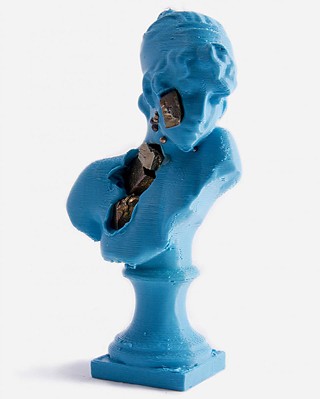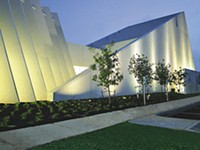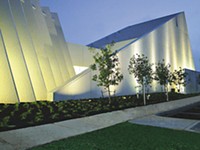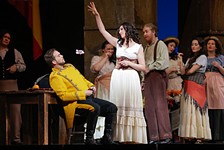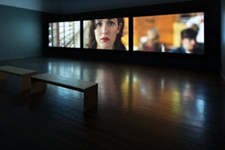"Hector Carmona Miranda: Concrete, Plastic & Metal" at the MACC
Sometimes you want more from the artist's 3-D printed busts and photographs of same, and sometimes you get it
Reviewed by Sam Anderson-Ramos, Fri., March 17, 2017
Hector Carmona Miranda's "Concrete, Plastic & Metal" reminds me of 19th century British photographer Julia Margaret Cameron. The show consists primarily of large photographs of 3-D-printed busts. The busts, mostly printed in blue plastic (an amazing phrase!), are also included in the show, encased in glass. Cameron was one of the earliest practitioners of photography as an art form. Before she came along, photography, which had been invented in the 1830s, had been used primarily for capturing "reality," that is, recording images of objects – landscapes, houses, wars, people – for posterity. Cameron was among the first to experiment with the medium's expressive qualities, using mostly women and children as props to act out fantastic scenes inspired by the Bible, among other things. Her most well-known works are portraits of beautiful young women and illustrious men, including Charles Darwin. Unlike more traditional photographers who used as much light as possible in order to limit exposure times, thus blowing out and flattening their images, Cameron used minimal light and asked her subjects to sit still for as long as it took (several minutes). The subjects, inevitably, swayed in place. The results are haunting images of slightly blurred faces with piercing eyes, floating out of a blacking darkness. Here, photography as art was forged.
However, it isn't Miranda's photographs that make me think of Cameron, but his 3-D-printed busts. Contemporary artists are bursting at the seams to make use of 3-D printers. The art school I worked at spent thousands to build an entire lab dedicated to their use. Artistic experimentation abounds with failed attempts to use the technology in an interesting, purposeful way. I have seen some successful experiments, but they are few and far between. Miranda's busts lean toward the successful, though they do have some space to grow. Literally, in fact, such as with Sappho, a bust of a coquettish woman, chin to upraised shoulder, hair tied back. The bust is perhaps seven inches high. Small bronze cubes have been embedded in her face and chest. One might think the bust is grotesque, but on the contrary, she seems more rapturous, possibly as a result of her exposed frailty, her beauty so easily threatened.
But I would like Sappho to be bigger, to "grow," to make her more formidable, less toylike. I want to be confronted by her, to see her imperfections and her intricacies. I may be getting my wish with Miranda's accompanying photographs, straightforward still lifes of the plastic busts, only I'm not entirely pleased with the images. They're too easy, perhaps. Too straightforward. They seem to be just out of touch with the full potential of photography, as well as the full potential of the busts. So they are not quite there. That said, they have their moments, like riveting, mysterious lights in space or hearing one's name said out loud in a crowd of strangers. Roland Barthes identified two major qualities of photographs: studium and punctum. Studium was the boring photograph with nothing notable about it. The punctum was the puncture, the point of emotional experience one might gather from any photo without warning. In Miranda's Nathalie de Laborde A, another plastic woman has her face gashed at her center with silver, but that is not the essential moment here. That moment can be found at the frayed base of the bust, where the imperfections in the printing process have resulted in a flaking, fragile disturbance, like dried skin. And there it is. The puncture. Finally. The art in the thing.
"Hector Carmona Miranda: Concrete, Plastic & Metal" at the MACC
Emma S. Barrientos Mexican American Cultural Center, 600 River St.www.maccaustin.org
Through March 25





